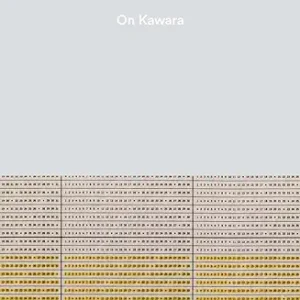On Kawara edited by Emily Wei Reis 2018
On Kawara is a Japanese-American conceptual artist whose work has varied in medium and style, but all informed by his sense of time, impermanance, and the paradox between the preciousness of every day and the totally forgettable events of almost every one of them.
I became fascinated by Kawara when viewing an exhibit entitled ‘Silence’ at the Guggenheim in 2015. It was one of those experiences that art is supposed to have for people, but I have not often felt it. Kawara with his Date Paintings, his postcards, telegrams, 100 year calendars and One Million Year volumes, and his meticulous records of where he went and who he saw was different. I loved the exhibit and on January 1, 2016 began my own practice of writing a daily postcard (or occasionally two) to friends and family. I expanded on Kawara’s practice by adding the number of days of my life and the number of postcards while continuing his practice of indicating where I was writing from and what time I got up. As of this morning, I’ve now sent 3081 of these cards from places as far away as Israel, Russia, Sweden, Alaska, and of course, Vermont and Cambridge. I love this daily experience of choosing a card, choosing an appropriate recipient, filling in the blanks, addressing it, putting the stamp on it, and dropping it at the post office or corner mail box. I have no expectation of hearing back from the recipient, though I often do.
This volume was published on the occasion of the Glenstone Museum in Potomac, Maryland opening its new Pavilion exhibition space. Kawara is one of a handful of artists who have a permanent presence in the Pavilion. Designed in conjunction with him before his untimely death in 2014, the space is an austere, gray, naturally lit from above room with only three Day paintings in it—the Moon Landing works. These paintings are part of the Today series painted over a 48 year period. There are more than 300 paintings in this series. Each one is created in a 24 hour period and consists of that day’s date painted in white paint in the language of the country where Kawara was workinge. The date is centered upon a background of blue, red, or gray on a canvas that is one of eight sizes he used. The three Moon Landing paintings represent the dates of the launch of the Apollo, its landing on the moon, and Neil Armstrong’s first steps there.
The book also contains images of all the Kawara works owned by Glenstone: 61 Date Paintings and the boxes and newspaper liners they sit in, a set of the ten volumes of One Million Years Past and One Million Years Future, a series of his one hundred year calendars, and a large number of postcards, telegrams (“I am still alive”), and lists of who he met and where he went on a given day.
There are also two essays in the book in addition to Reis’ excellent, readable introduction. One is E.B. White’s Talk of the Town column from The New Yorker on July 26, 1969 describing the scene in NYC as the Apollo crew landed on the moon. The second is a wonderful piece of work by Lynne Tillman, one of our most eclectic and accomplished critics. In her insightful exploration of Kawara’s work, she writes “He dedicated himself to a single lifelong project, the Today series in which he strove to emphasize the most ordinary and fundamental fact of life—having it.” She goes on to write, “How does an artist speak or respond to time, to make time count, to make time matter and turn the mattering into material?…Kawara devoted his work to the aeshetics of daily-ness….He avoided hyperbole and drama to attend to life’s little moments, to the passage of time, to everyday presence and loss….being alive is everything.”
This is a lovely book with a wonderful essay about a fascinating artist. It’s an excellent introduction to Kawara’s work and life as well as to a very special museum, Glenstone. I remain totally captivated by him and his work.



